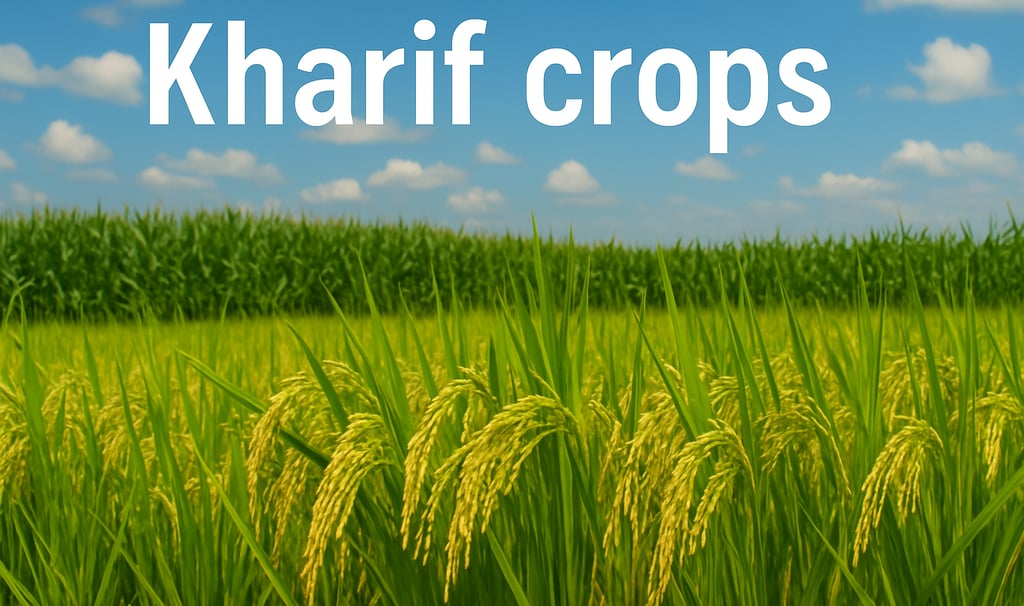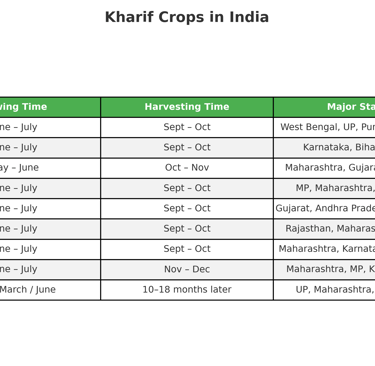Kharif Crops in India :Types, Climate & Soil Requirement
Kharif crops, also recognized as monsoon crops, are predominantly sown with the onset of the southwest monsoon and harvested at the end of the rainy season. India is one of the leading producers of several major kharif crops, including rice, maize, pulses, and cotton.
CROP MANAGEMENT
8/9/20259 min read


Introduction to Kharif Crops
Kharif crops, also known as monsoon crops, are a significant component of India's agricultural landscape. They are traditionally sown at the onset of the southwest monsoon, which typically begins in June and lasts until September. The growing season for these crops matches the rainy season, allowing them to benefit from the abundant rainfall prevalent during this period. It is during this time that farmers prepare their fields, utilizing traditional practices that have been handed down through generations, fostering a cultural link between agriculture and community.
These crops differ from rabi crops, which are sown in the cooler months from October to March. The climatic requirements for kharif crops include both high humidity and substantial rainfall, making them well-suited for various regions in India where monsoon conditions prevail. Major crops in this category include rice, maize, ensemble pulses, and cotton, all of which play vital roles in ensuring food security and supporting the livelihoods of millions of farmers across the country.
The regional significance of kharif crops is particularly pronounced in states such as Punjab, Haryana, Uttarakhand, and West Bengal, where agriculture forms the backbone of the economy. The production of kharif crops is crucial, not only for local consumption but also for national supply chains, contributing significantly to India's agricultural output. Additionally, the cultivation of kharif crops is often complemented by diverse cropping systems that integrate both traditional and innovative agricultural practices to enhance productivity and sustainability.
Understanding the dynamics of kharif crops is essential for grasping the broader picture of agriculture in India, including its economic implications, climate adaptability, and cultural significance. As the nation continues to evolve in its approach to agricultural practices, kharif crops will remain a cornerstone of India's economy and food security strategy.
Major Kharif Crops Grown in India
Kharif crops, also recognized as monsoon crops, are predominantly sown with the onset of the southwest monsoon and harvested at the end of the rainy season. India is one of the leading producers of several major kharif crops, including rice, maize, pulses, and cotton. Each of these crops plays a crucial role in the agricultural economy and food security of the nation.
Starting with rice, which is often considered the staple food for a significant portion of the Indian population, it is sown in various regions across the country. The crop thrives in areas with sufficient rainfall, preferring warm temperatures and high humidity. Nutritionally, rice offers carbohydrates, making it a primary energy source. Factors contributing to its cultivation include irrigation facilities, improved seed varieties, and methods that have enhanced yield quality over the years.
Maize, another vital kharif crop, is known for its versatility. It can be consumed as food, used in animal feed, and serves as a raw material for various food processing industries. It grows well in diverse climatic conditions and is cultivated in states like Karnataka, Andhra Pradesh, and Maharashtra. Attributing to its high protein and carbohydrate content, maize is a staple in several parts of rural India.
Pulses are essential for their nutritional value, providing protein, vitamins, and minerals. Common kharif pulses include pigeon pea and black gram. These crops are especially significant for resource-poor farmers, as they can be cultivated in a variety of soils and climatic conditions, enriching soil fertility through nitrogen fixation.
Lastly, cotton is another major kharif crop cultivated primarily for its fibers. This cash crop is crucial for the textile industry in India and significantly impacts the livelihood of farmers in regions such as Gujarat and Maharashtra. Cotton cultivation practices have evolved over the years to include the use of genetically modified seed varieties and improved pest management techniques, which have revolutionized productivity.
In conclusion, understanding the major kharif crops cultivated in India reveals their vital role in ensuring food security, supporting farmers’ livelihoods, and contributing to the agricultural economy. The comprehensive cultivation practices and their nutritional significance underline the importance of these crops in the country’s agricultural landscape.
Cultivation Practices for Kharif Crops
The cultivation of kharif crops, typically sown with the onset of the monsoon season, requires a series of well-structured practices to ensure optimal yield and sustainability. The first step in the cultivation process is soil preparation, which involves plowing and tilling the land to create a fine tilth. This promotes better aeration, drainage, and moisture retention, essential for the healthy growth of kharif crops.
Once the soil is adequately prepared, the selection of seeds is crucial. Farmers should choose high-quality seeds that are both disease-resistant and well-suited to the local climate and soil conditions. Crop varieties such as rice, maize, and soybeans are commonly cultivated during this season. Following seed selection, proper sowing techniques must be employed. Farmers can utilize methods such as broadcasting, dibbling, or trans planting, ensuring that seeds are sown at the correct depth and spacing according to crop requirements.
Irrigation practices play a vital role in the successful cultivation of kharif crops due to varying rainfall patterns. Farmers often rely on sustainable practices such as rainwater harvesting or drip irrigation to maximize water efficiency and minimize waste. Effective pest management strategies are also essential; adopting integrated pest management (IPM) practices can considerably reduce harmful impacts while ensuring the health of crops. This includes monitoring pest populations, using biological control agents, and implementing crop rotation to maintain balanced ecosystems.
Finally, harvesting is the stage that marks the culmination of the cultivation efforts. Timing is critical; crops should be harvested at full maturity to ensure maximum yield and quality. Best practices involve ensuring that harvesters are well maintained and that the harvested crops are promptly dried and stored to prevent spoilage. Through attentive soil management, seed selection, irrigation, and harvesting techniques, farmers can enhance their productivity and contribute to the sustainability of kharif crop cultivation in India.
Climate and Soil Requirements for Kharif Crops
Kharif crops, primarily sown with the onset of the southwest monsoon in June, have specific climate and soil requirements that are essential for optimal growth and yield. The ideal temperature range for these crops generally lies between 25°C and 35°C. Within this temperature band, seeds germinate effectively, and plants thrive, making it crucial for farmers to monitor local climatic conditions closely. Furthermore, kharif crops require abundant rainfall, typically between 75 cm and 150 cm during the growing season. The distribution of rainfall is equally significant; a steady, well-distributed monsoon is preferred over heavy downpours, which can lead to waterlogging and other related issues.
The type of soil also plays a vital role in the cultivation of kharif crops. Generally, well-drained, loamy soils enriched with organic matter are ideal for sustaining the necessary moisture levels while allowing for optimal drainage. Sandy loam and clayey loam soils are particularly advantageous as they can retain moisture effectively yet provide adequate aeration to the roots. Additionally, nutrient-rich soils with a neutral pH are preferred, as they enhance the growth potential of kharif crops, including paddy, maize, and various pulses.
Climate change poses a significant challenge to the traditional patterns of kharif agriculture. Fluctuations in temperature and altered rainfall patterns can adversely affect crop yields. Farmers must adapt to these changes by implementing effective soil and water conservation techniques, selecting crop varieties that are more resilient to climatic extremes, and incorporating agroforestry practices. Such adaptations not only help in mitigating the impacts of climate change but also promote sustainable agricultural practices, ensuring the long-term viability of kharif crop production in India.
Economic Importance of Kharif Crops
Kharif crops play a pivotal role in India's agricultural economy, significantly contributing to the nation's Gross Domestic Product (GDP). These crops, which include staples such as rice, maize, and pulses, are primarily sown with the onset of the southwest monsoon, making them crucial for ensuring food security in a country with a large population. The sector not only aids in fulfilling the dietary needs of millions but also serves as a backbone for rural economies, providing livelihoods to a substantial portion of the farming community.
Kharip Crops In India
The kharif cropping season contributes significantly to employment generation, particularly in rural areas where agriculture is the mainstay of livelihoods. It is estimated that a large percentage of the rural population relies on agriculture-related activities during the kharif season, from sowing to harvesting and marketing. This employment generation helps in alleviating poverty and improves the standard of living for many families involved in farming.
In terms of market dynamics, kharif crops are subject to various price fluctuations and trends influenced by factors such as climatic conditions, supply-demand imbalances, and international market trends. The lack of robust infrastructure and market access often leaves farmers vulnerable to price volatility, which can impact their overall income. This volatility can be exacerbated by insufficient storage facilities and a lack of information regarding market prices, making it imperative for the government to implement policies that ensure fair pricing and market access for these farmers.
Moreover, as the demand for kharif crops continues to rise due to population growth and changing dietary patterns, understanding their economic implications becomes increasingly vital. Efforts to stabilize prices and enhance market access can provide farmers with better returns and contribute to sustainable agricultural growth, ensuring that kharif crops remain a cornerstone of India's economic framework.
Challenges Faced by Kharif Crop Farmers
The cultivation of kharif crops in India presents various challenges that farmers must navigate to ensure successful harvests. Chief among these challenges is the impact of changing climate conditions. Variability in monsoon patterns has led to unpredictable rainfall, which is crucial for kharif crops like rice, maize, and soybeans. Such irregularities can result in crop stress or failure, significantly affecting yield and farmers’ livelihoods.
In addition to climate variability, pest invasions pose a substantial threat to kharif crop production. Farmers often face attacks from insects and diseases, which can quickly devastate crops if not managed effectively. The increasing resistance of pests to conventional pesticides has made it even more difficult for farmers to protect their crops, leading to decreased yields and financial losses. Alongside pests, diseases also play a critical role, necessitating the need for effective management strategies.
Water scarcity is another significant challenge confronting kharif farmers, particularly in regions that rely heavily on rain-fed agriculture. Over-exploitation of water resources and erratic rainfall patterns have led to insufficient soil moisture, putting crops at risk. This scarcity not only affects the quantity of the harvest but also influences the quality of the produce, impacting market prices and farmers' income.
Furthermore, changing market dynamics pose additional complications for kharif crop farmers. Fluctuating prices and market demands can make it difficult for farmers to secure fair compensation for their produce, sometimes leading to financial instability. To address these challenges, the government has introduced multiple initiatives aimed at supporting farmers. Programs focused on increasing access to quality seeds, improving irrigation facilities, and providing financial assistance are essential steps towards enhancing the resilience of kharif farmers.
Future of Kharif Agriculture in India
The future of kharif agriculture in India holds immense promise, driven by advancements in farming technology, sustainable practices, and supportive policy frameworks. Innovations such as precision agriculture, drones for monitoring crop health, and genetically modified seeds are poised to enhance productivity. These technologies not only improve yield but also optimize resource usage, addressing water scarcity concerns prevalent in several regions.
Furthermore, sustainable agricultural practices are becoming increasingly vital. Integrating organic farming, intercropping, and soil health management can mitigate environmental impact, contributing to long-term agricultural resilience. Such practices help in maintaining soil fertility and combating the adverse effects of climate change, which threatens traditional farming methods. As kahrif crops such as rice, maize, and pulses are susceptible to fluctuations in weather patterns, adopting sustainability measures becomes crucial for food security.
Policy changes are also pivotal in shaping the future landscape of kharif agriculture. The Indian government has acknowledged the need for farmer-centric policies that enhance income and reduce vulnerability. Through initiatives focusing on minimum support prices, crop insurance schemes, and credit facilities, policymakers aim to create a more sustainable and equitable agricultural framework. Supporting research and development is equally important. Disciplines such as agronomy and molecular biology should continue exploring innovative solutions that enhance crop resilience and yield under changing climatic conditions.
In addition to technology and policy, educating farmers is essential. Training programs can equip them with the skills necessary to adopt modern farming techniques and practices. Encouraging cooperative farming can also improve economic outcomes by pooling resources and sharing knowledge, allowing farmers to compete more effectively in larger markets. Overall, the comprehensive approach involving technology, sustainability, policy reform, and education will greatly influence the trajectory of kharif agriculture in India, ensuring its viability for generations to come.
You May Like To Read "Types of Soil: A Comprehensive Guide"








"Boosting Crop Growth With Nature's Power"
Contact Us:
E Mail: support@frosil.com
Customer Care: +91 8329592991
FROSIL © 2025. All rights reserved.


'Frosil' is a fertilizer manufacturer committed to enhancing soil health and crop yields. We provide high-quality, eco-friendly products that support sustainable agriculture and help farmers achieve optimal results.
Registered Office: Gat No.96, Near Krushnai Hospital, Tandali. Tal- Shirur, Dist- Pune.
